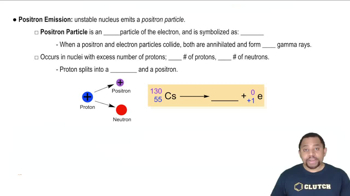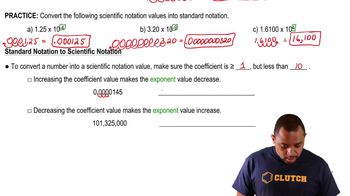In 2010, a team of scientists from Russia and the United States reported creation of the first atom of element 117, which is named tennessine, and whose symbol is Ts. The synthesis involved the collision of a target of 24997Bk with accelerated ions of an isotope which we will denote Q. The product atom, which we will call Z, immediately releases neutrons and forms 294117Ts: 24997Bk + Q → Z → 294117Ts + 3 10n (b) Isotope Q is unusual in that it is very long-lived (its half-life is on the order of 1019 yr) in spite of having an unfavorable neutron-to-proton ratio (Figure 21.1). Can you propose a reason for its unusual stability?
Ch.21 - Nuclear Chemistry
Chapter 21, Problem 81a
Each of the following transmutations produces a radionuclide used in positron emission tomography (PET).
(a) In equations (i) and (ii), identify the species signified as 'X.'
(i) 14N(p,α)X
(ii) 18O(p,X)18F
(iii) 14N(d,n)15O
 Verified step by step guidance
Verified step by step guidance1
Identify the type of nuclear reaction occurring in each equation. For example, (i) and (ii) involve proton bombardment, while (iii) involves deuteron bombardment.
For equation (i) \( ^{14}\text{N} + ^1\text{p} \rightarrow \alpha + ^2\text{X} \), recognize that an alpha particle (\( \alpha \)) is a helium nucleus \( ^4\text{He} \). Use the conservation of mass and atomic numbers to find \( X \).
For equation (ii) \( ^{18}\text{O} + ^1\text{p} \rightarrow X + ^2\text{18}\text{F} \), apply the conservation of mass and atomic numbers to determine \( X \). Remember that \( ^{18}\text{F} \) is a fluorine isotope.
For equation (iii) \( ^{14}\text{N} + ^1\text{d} \rightarrow \text{n} + ^2\text{15}\text{O} \), note that \( ^1\text{d} \) is a deuteron (\( ^2\text{H} \)) and \( \text{n} \) is a neutron. Use conservation laws to find the missing species.
Verify your results by ensuring that both the mass numbers and atomic numbers are balanced on both sides of each equation.

Verified video answer for a similar problem:
This video solution was recommended by our tutors as helpful for the problem above.
Video duration:
9mWas this helpful?
Key Concepts
Here are the essential concepts you must grasp in order to answer the question correctly.
Nuclear Transmutation
Nuclear transmutation is the process by which one element or isotope is converted into another through nuclear reactions. This can occur naturally or artificially, often involving the bombardment of nuclei with particles such as protons or neutrons. Understanding this concept is crucial for identifying the species 'X' in the given equations, as it relates to how elements change during these reactions.
Recommended video:
Guided course

Nuclear Binding Energy
Radionuclides and Positron Emission Tomography (PET)
Radionuclides are unstable isotopes that decay and emit radiation, which can be harnessed in medical imaging techniques like positron emission tomography (PET). In PET, radionuclides are used to visualize metabolic processes in the body. Recognizing the role of radionuclides in PET is essential for understanding the significance of the transmutations described in the question.
Recommended video:
Guided course

Positron Emission
Nuclear Notation
Nuclear notation is a shorthand representation of an atomic nucleus, indicating the element's symbol, atomic number, and mass number. For example, in the notation 14N1, '14' represents the mass number (total protons and neutrons), while '1' indicates the atomic number (number of protons). Familiarity with nuclear notation is necessary to interpret the equations and identify the unknown species 'X' accurately.
Recommended video:
Guided course

Standard Notation to Scientific Notation
